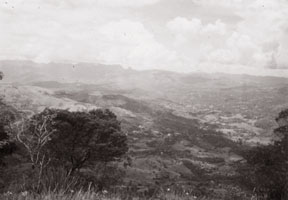|
observer |
|
|
|
|
|
OTHER LINKS |

|

|

|
|
Environment series: Trees and collective goodsPlants so often taken for granted in moist, tropical countries like Sri Lanka, are perhaps one of the greatest of natural assets available to a country. They utilize water and (food of animals) and oxygen. To perform this amazing bit of chemistry, plants use the energy in sunlight.
For this reason, they have often been described as the most efficient of solar collectors. Trees are even more spectacular in this respect, for much of the suns energy is stored in the form of wood and is directly utilizable by man through combustion. Other forms of direct utilization of the stored energy of the sun include food, lumber, pulp, etc. The forested hills 'The physical effects of trees in controlling erosion are evident when a logged area is observed. Without the upper canopy of leaves to absorb the force of falling rain, the leaf litter to regulate surface flow and the root system to bind the soil, topsoil erosion are greatly increased. The hills of Sri Lanka were almost completely forested up to about 150 years ago. The rain forests, of which the Sinharajah is a pitiful remnant, once extended from Alawwa in the north to Matara in the South. The earth-slips of the Mahaveli catchment, the silting of the Castlereagh reservoir and the rapid flow of the topsoil to the sea are all consequences of this loss. Thus, it does seem that trees are enormously important in a national scale to protect the stability and add to the productivity of a nation. Modern research has demonstrated that trees are of great utility on an individual or local waste products of living animals (carbon dioxide) to form sugars. Studies conducted by the USDA Forest Service have demonstrated that transpiration from a single tree can produce up to 600,000 BTUs per day for cooling. In commonplace equivalents, this would be equal to five room-sized air conditioners running about 20 hours per day. As modern concrete buildings store and radiate heat, contributing to a general increase in the ambient heat in their surroundings, the present plans of the Government, requiring a mandatory minimum of trees in urban development demonstrate sensitivity to public needs. The addition of heat to the local environment is as much a use of collective property as the addition of pollutants to the air or to water and requires taxation accordingly. Trees are also useful in urban areas as air filters. The capacity of trees to absorb noxious gases has been amply demonstrated by recent research. In addition, they enrich and purify the air by oxygen emission, a by-product of photosynthesis. Another important element in air filtration by trees is the ability of leaves to trap or reflect airborne dust, dirt and other particulate matter. In a study done by the US Park Service, street trees were found to be able to reduce dust particle counts by as much as 75 per cent. Alleviating noise pollutionTrees also address the unwelcome facet of noise pollution in the modern urban situation the fact that a noisy environment leads to mental stress and fatigue has been demonstrated in many medical studies. Trees contribute greatly in alleviating this problem, especially if used in combination with landforms. When trees are placed in properly designed units, they attenuate noise by absorption, reflection and scattering. Well-designed units for acoustical control have been shown to reduce noise by 40 per cent or more. There are many other functions that trees fulfil in the urban environment. These range from glare and reflection prevention, to wind and water erosion control. It will be noticed that old-fashioned economists generally take none of the goods and services listed above into account. The environment represents a collective good, but its use has hitherto remained free. It is this aspect that has led to the killer smogs of Tokyo and Los Angeles. The present decision by the Government to recognize in living trees in excess of the timber value is recognition of the goods and services provided by living trees. Economists would do well to study this aspect of the public or collective goods. (END). The article above was first published in June 1980. Our national tree stock was to be valued in terms of its ecosystem services. Urban landscaping and planting as well as the national tree stock was to be increased. What really happened was the opposite. Far from increasing our tree cover and maintaining old growth we have reduced it. Fruit trees; traditionally protected from time immemorial have been delivered to the sawmill, through government decree. Plantations, grown to meet with the timber shortfalls of the nation, are being certified for export, while we import the timber of the disappearing Asian forests as a consequence. Rotating door policy decisions to control or relax timber transport regulation hampers a fair timber market. There is no sale of sequestered carbon stocks. Twenty-Five years later, the information is still pertinens, the potential still existent. Perhaps it is time to debate the value of trees for their environmental services once again! We must learn to recognize of the goods and services provided by living trees excess of the timber value. |









